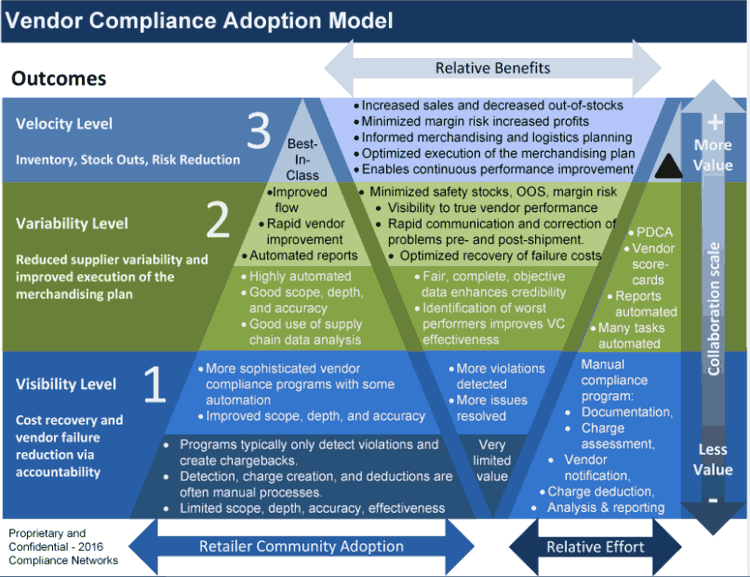Last month, we provided an overview of retail Vendor Compliance Programs (VCP).
As we noted then, the visibility from a robust vendor compliance system that supports a VCP and the improvement in overall and individual vendor performance have major impacts on a retailer’s supply chain effectiveness, ultimately in terms of service to the store and increasingly to the omnichannel consumer as well.
Compliance Networks Says... |
 |
| As a retailer matures in their VCP efforts, they create a predictable supply chain performance, which informs the merchandising and logistics planning while encouraging improvement throughout the supply chain. |
 |
|
|
A VCP also provides a platform for:
• Identifying vendor failures and recovering the associated costs
• Reducing labor costs by minimizing problem shipments and streamlining inbound auditing
• Reducing the amount of required safety stock
Improving customer satisfaction and sales
Last time, we also introduced our Vendor Compliance Adoption Model, illustrated again here in the graphic below.

This graphic illustrates the three levels of vendor compliance sophistication and value: visibility, variability, and velocity.
Each maturity level provides different degrees of visibility, variability, and velocity benefits. However, it is important to note that as retailers improve the design and execution of their Vendor Compliance Programs they can expect to move into outcome levels that are best described by their focus on visibility, variability, or velocity, as discussed below.
Visit the Retail Vendor Performance Management home page to learn more
and subscribe to the monthly newsletter.
First Outcome Level: Visibility
Vendor Compliance Programs establish vendor accountability for following published guidelines. If and when these guidelines are breached, penalties are assessed and notifications are delivered to the vendor. The penalty corresponds to the cost directly associated for remediation or recouping lost sales.
The intent of these penalties is not punitive. It is to encourage execution of the merchandising plan. Accountability is best supported when automated processes are involved. Manual efforts to detect violations are not as accurate or complete, and are more costly than automated detection strategies.
A Visibility-level organization’s efforts and execution are predominately manual. There is little to no automation for identifying breaches, assessing penalties and notifying vendors.
Beyond manual detection of vendor failures, a basic VCP provides retailers with modest visibility into the performance of their inbound supply chains. Depending on the design and execution of the entry-level VCP, this visibility may or may not provide an accurate and timely view. Regardless of the quality of the data produced, it is highly likely that a manual, entry-level VCP will be limited in scope, depth, and functionality.
A basic VCP is of limited value in terms of optimizing supply chain execution of the merchandising plan. If poorly designed or executed, a basic VCP can even sometimes do more harm than good. An example would be inconsistent application of retailer routing guide rules across the vendor community or failure to notify vendors of violations in a timely manner with complete information.
Second Outcome Level: Variability
VCPs leverage data to reduce variation in supply chain activities and by doing so they improve decision-making performance. Objective information is now available to assist stakeholders to manage their organizations so as to develop a continuous improvement cycle.
A second-level organization automates vendor compliance failures, penalties and notifications (with supporting documentation), which drives immediate improvements in vendor performance, thus reducing variability.
Third Outcome Level: Velocity
Objective historical supply chain performance data enables the retailer to base its merchandising plans on facts.
Historical vendor performance is assessed to anticipate future vendor performance. This predictability is leveraged to make short term order adjustments based on a vendor’s record of shortages and overages. Velocity-level retailers can also adjust their order timing to accommodate vendor tendencies.
The power of predictability is that the retailer can take advantage of these tendencies in the short term, while encouraging behavior changes in the long term from the vendor.
A Velocity-level organization embraces predictability which enables the retailer to optimize its merchandising plan execution and significantly improve the prospects of reducing variability in on time and complete performance.
Benefits of Vendor Compliance Optimization
As a retailer matures in their VCP efforts, they create a predictable supply chain performance, which informs the merchandising and logistics planning while encouraging improvement throughout the supply chain.
Improved sales result from having accurate inventory on hand. Reduced inventory costs are enabled by less need for safety stock. A reduction of manual efforts reduces overhead and reduces oversight risk.
As inbound supply chain performance improves, logistics stakeholders are better able to accurately and efficiently execute the merchandising plan.
Any comments on this article? Please send below.
Your Comments/Feedback
|